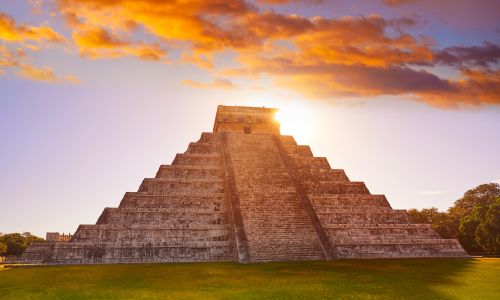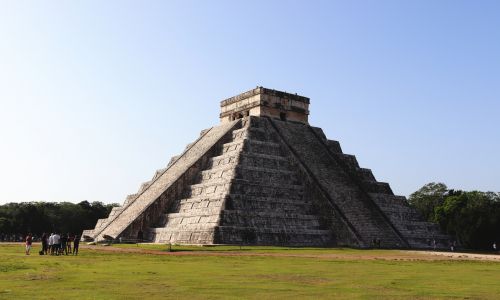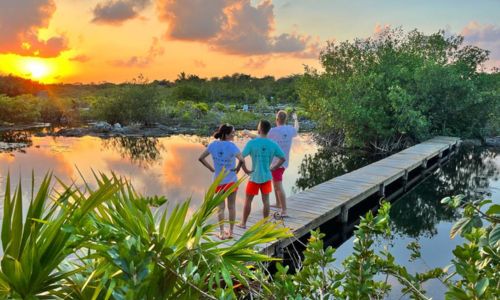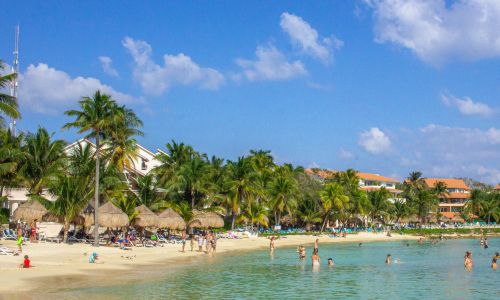
There are few places on earth where you can see time itself, but Chichén Itzá—one of the New Seven Wonders of the World—is one of them.
Every year, thousands gather at the famed Temple of Kukulcán (El Castillo) to witness a shadowy serpent descend the pyramid’s edge during the spring and fall equinoxes, and to observe rare alignments of light and stone during the winter solstice. These events, rooted in Maya cosmology, are a mesmerizing combination of science, art, and ritual—an experience that leaves a lasting impression long after the sun sets.
But what’s it like to actually be there? What happens during each season? And how can you turn this moment into a full cultural getaway that blends magic, history, and coastal relaxation?
Let’s explore the seasonal phenomenon of Chichén Itzá and how you can make the most of your visit with a 7-day cultural itinerary in Riviera Maya, curated with Locogringo’s signature touch.

What Happens at Chichén Itzá During the Equinoxes and Solstices?
Spring Equinox (Around March 20–21):
As day and night reach perfect balance, the shadow of a feathered serpent appears along the northern steps of El Castillo. Visitors from around the world gather to witness the illusion of Kukulcán “slithering” down the pyramid—a powerful representation of rebirth, fertility, and cosmic harmony in Maya tradition.
Summer Solstice (Around June 20–21):
The longest day of the year was a time of great agricultural and astronomical importance for the Maya. While the serpent shadow does not appear, the Temple of the Sun and other observatories within Chichén Itzá align with the rising sun, emphasizing the sacred role of solar cycles in Maya cosmology. The summer solstice offers early-morning clarity, longer visiting hours, and vibrant jungle foliage, making it ideal for photographers and early risers seeking a quieter yet still meaningful experience.
Fall Equinox (Around September 21–23):
The magical serpent illusion returns as light and shadow once again align on El Castillo. With fewer crowds and more comfortable weather, the fall equinox is one of the most favorable times to visit, offering dramatic sunsets, lower humidity, and a more reflective, serene atmosphere.
Winter Solstice (Around December 21–22):
The longest night of the year held deep meaning in Maya cosmology, symbolizing the sun’s descent into the underworld. While there is no shadow serpent effect, this date evokes a spiritual ambiance. Visitors often describe a sense of connection to the ancient rituals once performed here. Cooler weather and clear skies make it an ideal time to explore both the ruins and surrounding towns like Valladolid or Mérida.

When Is the Best Season to Visit Riviera Maya to Experience the Equinox or Solstice?
If you’re planning a trip to witness the magic of the equinox or solstice at Chichén Itzá, the best seasons to visit are fall, winter, and spring. These times of year not only align with key astronomical events, but also offer the most favorable travel conditions across the Riviera Maya:
Fall Equinox (late September): Fewer crowds, cooler temperatures, and stunning sunsets make this one of the most enjoyable and intimate times to witness the serpent shadow event.
Winter Solstice (late December): A deeply symbolic and spiritual moment in Maya culture, with dry weather and comfortable temperatures ideal for exploring ruins, colonial towns, and cenotes.
Spring Equinox (late March): A popular and festive time to visit, with balanced weather, blooming jungle landscapes, and the awe-inspiring return of Kukulcán’s descent down the pyramid.
Each of these seasons pairs the powerful cultural energy of the Maya calendar with the natural beauty and comfort of Riviera Maya’s best weather—making your solstice or equinox trip both meaningful and magical.

7-Day Equinox or Solstice Cultural Itinerary in Riviera Maya
Explore the heart of the Yucatán with Locogringo
Day 1: Arrive & Unwind
Settle into your private beachfront vacation rental in Akumal, Puerto Aventuras, or Soliman Bay—ideal locations for access to all major cultural sites without the chaos of resort towns. Spend the day exploring your home-away-from-home and soaking in the view.
Day 2: Journey to Chichén Itzá (Equinox or Solstice Day)
Rise early and head to the sacred city of Chichén Itzá. Witness the alignment of shadows and light, and immerse yourself in one of the most unique cultural spectacles on Earth. Enjoy lunch in Valladolid or explore nearby cenotes before returning home inspired.
Day 3: A Day at Sea
Book a catamaran or yacht charter departing from Puerto Aventuras Marina. Whether it’s fishing, snorkeling, or just basking in the Caribbean sun, this is your chance to connect with the sea. End your day dining at one of the marina’s waterfront restaurants.
Day 4: Nature & Conservation in Akumal
Visit the Centro Ecológico Akumal (CEA) and learn how sea turtles have returned here for generations. Explore the bay by paddleboard or simply observe the incredible biodiversity right off the shore.
Day 5: Akumal Beach & Local Flavor
Stroll the boutiques and art galleries of Akumal Pueblo. Sample handmade tortillas, shop for handcrafted souvenirs, and connect with the living culture of the region through food and folklore.
Day 6: Rest & Reflect
Relax by your private pool or book an in-villa massage. If you’re up for a light adventure, visit a nearby cenote or take a short drive to Tulum for a sunset view from its cliffside ruins.
Day 7: Farewell for Now
Enjoy one last swim or morning walk along the beach before heading home with memories of ancient temples, turquoise waters, and meaningful connections.
Ready for Your Own Equinox or Solstice Journey?
Let Locogringo help you create a vacation that’s more than a getaway—it’s a once-in-a-lifetime connection with history, nature, and the spirit of the Riviera Maya.
Contact us today at reservations@locogringo.com or message us directly to plan your solstice or equinox experience with a personalized itinerary and local insights.
